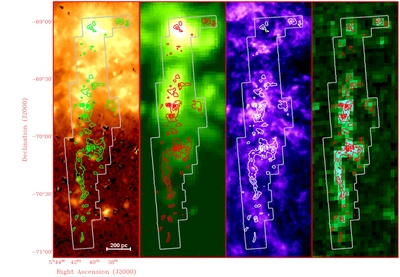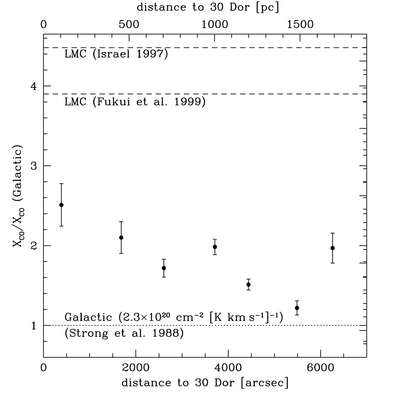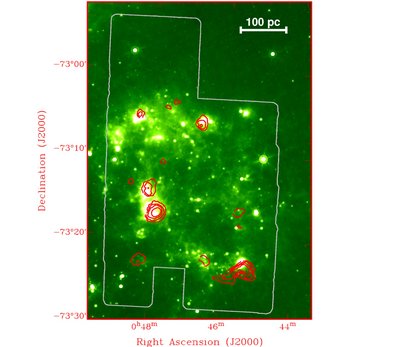Shining a bright light on cold gas in the Magellanic Clouds
|
Jürgen Ott (ATNF), Jorge Luis Pineda Gálvez (AIfA, University of Bonn, Germany), Tony Wong (School of Physics, University of NSW & ATNF), Annie Hughes (Swinburne University of Technology & ATNF), Erik Muller (ATNF), and the LMC/SMC team
The Large and Small Magellanic Clouds (LMC and SMC respectively) are two gas-rich galaxies that are interacting with each other as well as with our Milky Way. Due to their proximity, the Magellanic Clouds are excellent laboratories for studying processes on scales that are difficult to investigate in the Milky Way due to our position within the Milky Way's disk. Furthermore, the LMC and SMC are dwarf galaxies that are less evolved than giant spiral galaxies like the Milky Way. Having experienced fewer generations of star formation, the interstellar medium in the Magellanic Clouds has a low metal content (LMC: 30%, SMC: 10% of solar metallicity), similar to the enrichment levels observed in the early Universe. A key ingredient to form stars is molecular gas. This gas phase is formed in regions that are cool and dense enough to favour the formation of molecular hydrogen (H2) from neutral hydrogen (HI). Stars are formed at a range of masses; the most massive exhausting their nuclear fuel quickly and returning large amounts of energy to the ambient interstellar medium. This process of "feedback" - which takes the form of strong stellar radiation and winds as well as supernova explosions - exerts a strong influence on the physical and chemical properties of the molecular gas phase. The most massive star-forming region in the Local Group of galaxies is the 30 Doradus (30 Dor) region, located in the LMC (see Figure 1). Due to the presence of massive young stars, the 30 Dor region exhibits a very high radiation field, observable in the Hα line of ionised hydrogen (shown in red in Figure 1 and the first panel in Figure 2). The formation of stars in this region is sustained by a chain of molecular clouds extending south from 30 Dor. This combination of an extreme radiation field and the long chain of molecular gas that stretches from 30 Dor into a relatively quiescent region of the LMC is a rare find. It is therefore an unparalleled laboratory to study the influence of the interstellar radiation field on molecular gas. A team of researchers from ATNF, University of Bonn and Max-Planck-Institute for Radioastronomy (Germany), Nagoya University (Japan), University of NSW, and Swinburne University of Technology was formed to observe this molecular feature in the LMC with the ATNF Mopra telescope. The observations were taken for most prominent molecular line, carbon monoxide (CO (1-0)), at the highest spatial resolution to date. The observed field consists of about 140 individual 5 x 5 arcmin sub-maps and required approximately 200 hours of total observing time. The observations were performed at a spatial resolution of approximately 35 arcsec (corresponding to 9 parsecs). This is about a five times higher linear resolution as compared to that previously observed with the NANTEN telescope (Fukui et al. 1999, see the overlay of the NANTEN and the Mopra maps in Figure 2). The resulting map is shown in Figure 1 (right panel), smoothed to a resolution of 45 arcsec to improve the signal-to-noise. Figure 2 shows contours of the Mopra molecular gas data overlaid on observations at other wavelengths. The radiation field is traced by the Hα emission line of hydrogen, for example, and also by far-infrared emission from dust. About half of the molecular ridge appears to be immersed in a very intense field of ionising radiation. Molecular clouds seem to be rarer where the ionising radiation is strongest, but the most massive clouds of molecular gas - associated with the N159 HII region - are also located in the strong field. As shown in the third panel of Figure 2 the molecular gas appears to occur where there are large aggregations of neutral gas (as traced by HI). However, a close inspection reveals that the peaks of the HI and CO emission never coincide, but are separated by a few tens of parsecs, i.e. the molecular gas usually occurs in local minima of the neutral gas. This may indicate that a certain column density threshold must be reached in order to form molecules, but the conversion of atomic gas into molecular gas depletes the neutral HI. The high spatial resolution of the Mopra data is indispensable for a decomposition of the molecular ridge into individual clouds. In a first analysis, the team were able to identify about 150 individual molecular clouds, using a Gaussian decomposition method (Kramer et al. 1998). Applying the virial theorem, they derived the CO masses and hence the amount of H2 in the gas. H2 is the most abundant molecular species but is notoriously hard to observe (because the H2 molecule lacks a permanent dipole moment). To determine the amount of H2, and thus the total molecular gas mass, a CO-to-H2 conversion factor (the "XCO factor") is used to convert a measured flux of the CO (J = 1-0) line to a H2 column density. For many galaxies, in particular those observed in the very young Universe, the XCO factor is often the only means to derive the amount of molecular gas present and hence determine the galaxy's star-formation efficiency. However, the dependence of XCO on parameters such as metallicity and the ambient radiation field remains unclear and controversial. With the new Mopra data, the team were able to investigate the dependence of XCO on the strength of the radiation field. It was possible to disentangle this variable from other variables that do not change within the LMC. Figure 3 shows a graph of XCO (in units of the Galaxy's value) as a function of distance from 30 Dor. They found that XCO in the LMC is larger than measurements of XCO in the Milky Way. The Mopra data also places XCO in the LMC below previous estimates which suffer from poorer resolution. The analysis further indicates that XCO in the LMC is influenced by the intensity of the radiation field, i.e. the XCO factor increases towards the stronger radiation field near 30 Dor. As part of this Magellanic-wide survey, the group has also begun a survey for CO towards the brightest identified star formation region within the SMC: N27 and surrounds. The CO emission within the SMC is extremely weak, being an order of magnitude lower than that of the LMC, and requires substantially deeper observations. At this preliminary stage, the CO emission regions appear to be generally well correlated with bright infrared emission. The distribution of dust, measured from the Spitzer telescope (24 μm image, Bolatto et al. 2006) is shown in Fig. 4, overlaid with contours of CO emission detected by Mopra. The spatial coincidence of the dust and gas highlights the important role that dust plays in forming, and shielding the molecular gas within this very metal-poor galaxy. References: Bolatto, A., et al. 2006, in prep. Fukui, Y., et al. 1999, PASJ 51, 745 Israel, F. P. 1997, A&A, 328, 471 Kim, S., et al. 1998, ApJ, 503, 674 Kramer, C., Stutzki, J., Rohrig, R., & Corneliussen, U. 1998, A&A, 329, 249 Strong, A. W., et al. 1988, A&A, 207, 1 back to highlights page |
 Figure 1: The left panel shows a three-colour composite image of the Large Magellanic Cloud. Neutral hydrogen (HI) is coloured blue, Hα emission is red, and green is an optical (R-band) image. The 30 Doradus region, marked by the arrow, is the most actively star forming region in the Local Group. The grey area marks the region covered by our Mopra observations of the CO molecule (white contours) and a blow-up of the corresponding map is shown in the right panel.  Figure 2: An overlay of the contours of the CO map shown in the right panel of Figure 1 on images at other wavelengths. From left to right: Hα emission (SHASSA survey), far-infrared IRAS 100 μm emission from dust, neutral hydrogen (Kim et al. 1998), and the CO (J = 1-0) emission previously observed with the NANTEN telescope (Fukui et al. 1999).  Figure 3: The CO-to-H2 (XCO) conversion factor (normalised on the Galactic value from Strong et al. 1988) along the molecular ridge as a function of distance from 30 Dor. Previous measurements of XCO in the LMC are marked as dashed horizontal lines.  Figure 4: Contours of the first Mopra CO (J = 1-0) observations toward the south-west of the SMC overlaid on a Spitzer 24 μm image of dust (taken from Bolatto et al. 2006). |
